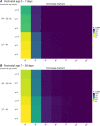Oral and Intravenous Amoxicillin Dosing Recommendations in Neonates: A Pooled Population Pharmacokinetic Study
- PMID: 37757471
- PMCID: PMC10686957
- DOI: 10.1093/cid/ciad432
Oral and Intravenous Amoxicillin Dosing Recommendations in Neonates: A Pooled Population Pharmacokinetic Study
Abstract
Background: There is a lack of evidence on oral amoxicillin pharmacokinetics and exposure in neonates with possible serious bacterial infection (pSBI). We aimed to describe amoxicillin disposition following oral and intravenous administration and to provide dosing recommendations for preterm and term neonates treated for pSBI.
Methods: In this pooled-population pharmacokinetic study, 3 datasets were combined for nonlinear mixed-effects modeling. In order to evaluate amoxicillin exposure following oral and intravenous administration, pharmacokinetic profiles for different dosing regimens were simulated with the developed population pharmacokinetic model. A target of 50% time of the free fraction above the minimal inhibitory concentration (MIC) with an MICECOFF of 8 mg/L (to cover gram-negative bacteria such as Escherichia coli) was used.
Results: The cohort consisted of 261 (79 oral, 182 intravenous) neonates with a median (range) gestational age of 35.8 weeks (range, 24.9-42.4) and bodyweight of 2.6 kg (range, 0.5-5). A 1-compartment model with first-order absorption best described amoxicillin pharmacokinetics. Clearance (L/h/kg) in neonates born after 30 weeks' gestation increased with increasing postnatal age (PNA day 10, 1.25-fold; PNA day 20, 1.43-fold vs PNA day 3). Oral bioavailability was 87%. We found that a twice-daily regimen of 50 mg/kg/day is superior to a 3- or 4-times daily schedule in the first week of life for both oral and intravenous administration.
Conclusions: This pooled population pharmacokinetic description of intravenous and oral amoxicillin in neonates provides age-specific dosing recommendations. We conclude that neonates treated with oral amoxicillin in the first weeks of life reach adequate amoxicillin levels following a twice-daily dosing regimen. Oral amoxicillin therapy could therefore be an adequate, cost-effective, and more patient-friendly alternative for neonates worldwide.
Keywords: absorption; amoxicillin; neonates; pharmacokinetics.
© The Author(s) 2023. Published by Oxford University Press on behalf of Infectious Diseases Society of America.
Conflict of interest statement
Potential conflicts of interest. F. M. K. reports an ESPR travel grant. R. F. K. reports participation on a data and safety monitoring board or advisory board for the PROTEA study (Protecting late-moderate preterm infants from respiratory tract infections and wheeze in their first year of life by using bacterial lysates). B. C. P. K. reports grants or contracts from ZonMw, the Dutch government, and the AIDS Foundation and a leadership or fiduciary role with EPASG, EC ESCMID, Council IATDMCT, and UEMS Pharmacology. J. H. reports payment or honoraria for teaching the Dutch pediatric antibiotics course for pediatric trainees and pediatricians. All remaining authors: No reported conflicts of interest. All authors have submitted the ICMJE Form for Disclosure of Potential Conflicts of Interest. Conflicts that the editors consider relevant to the content of the manuscript have been disclosed.
Figures



References
-
- Fjalstad JW, Stensvold HJ, Bergseng H, et al. Early-onset sepsis and antibiotic exposure in term infants: a nationwide population-based study in Norway. Pediatr Infect Dis J 2016; 35:1–6. - PubMed
-
- Litz JE, Goedicke-Fritz S, Härtel C, Zemlin M, Simon A. Management of early- and late-onset sepsis: results from a survey in 80 German NICUs. Infection 2019; 47:557–64. - PubMed
-
- Puopolo KM, Benitz WE, Zaoutis TE. Management of neonates born at ≥35 0/7 weeks’ gestation with suspected or proven early-onset bacterial sepsis. Pediatrics 2018; 142:e20182894. - PubMed
-
- de Hoog M, Mouton JW, van den Anker JN. New dosing strategies for antibacterial agents in the neonate. Semin Fetal Neonatal Med 2005; 10:185–94. - PubMed
Publication types
MeSH terms
Substances
Grants and funding
LinkOut - more resources
Full Text Sources
Medical

